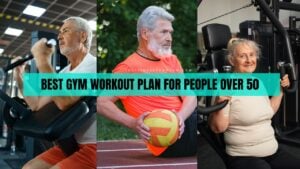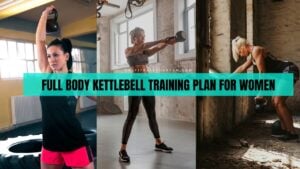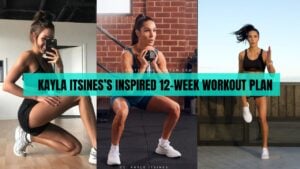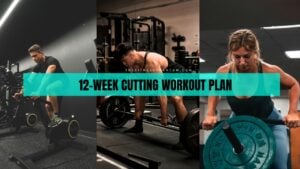Whether you’re a male or female, it is best to begin your workout journey with bodyweight exercises.
Bodyweight workout training helps develop fundamental strength, build lean mass, improve cardiovascular fitness, and scale your fitness to the next level.
You can perform myriad bodyweight exercises to strengthen your entire muscle group at home. However, you need a well-crafted workout plan to train in an organized manner and level up your fitness.
In this article, I’ve shared an ultimate three-day beginner bodyweight workout routine that builds strength and muscle and will help you get in shape over time.
This guide can help if you’re looking for a comprehensive, easy-to-follow, and effective workout plan for beginners.
Full Body 3-Day Beginner Bodyweight Workout Routine to Build Muscle and Get in Shape (No Equipment)
This program involves training three times weekly, focusing on all major muscles each training day.
It is suitable for every male and female who wants to bolster their foundational strength, shape their physique, and level up their fitness for resistance exercises.
Here’s a brief summary of this training plan:
- Recommended Program Duration: 8 Weeks
- Routine Type: Full Body Bodyweight Workout
- Sessions/Week: Three
- Duration/Session: 30 minutes
- Target Gender: Both Males and Females
- Experience Level Require: Beginner
- Equipment Needed: None, Bodyweight Exercises only
- Workout Goal: Develop fundamental strength, build lean mass, and improve body composition
- Best time to work out: Any time of the day that suits you the most
- Plank to follow next: 90-Day Home Workout Routine
Start your workout with 2-3 minutes of quick warm-up. A warm-up helps increase body temperature and prepares your muscles for intense exercises. You can do jumping jacks, leg swings, ankle hops, squat jumps, mountain climbing, etc.

Day 1
| Exercise | Target Muscles | Sets x Reps |
|---|---|---|
| Basic Squats | Quads and Glutes | 4 x 15-20 |
| Kneeling Pushup | Chest and Triceps | 3 x 10-12 |
| Superman Pull | Back and Shoulder | 4 x 10-12 |
| Shoulder Taps | Abs and Shoulder | 3 x 10/side |
| Glute Bridge | Glute and Hamstring | 3 x 12-15 |
| Reverse Crunches | Abdominals | 3 x 10-12 |
Exercise #1 – Basic Squat

- Stand straight with your feet shoulder-width apart, toes pointing slightly out, and arms together close to your chest.
- Brace your abdominal muscles, push your hips backward, and bend your knees to squat down until your thighs are parallel to the ground.
- Pause for a moment, then slowly return to the start.
Exercise #2 – Kneeling Pushup

- Sit on your knees, extend your torso, and place your palms on the floor (arms straight below your shoulders).
- Bend your elbows to lower your body toward the floor until your chest nearly touches the floor.
- Hold for a second, then push into the floor until your elbows are extended.
Exercise #3 – Superman Pull

- Lie on your stomach, face downward with your arms extended in front of you, palms facing the floor, and legs straight behind.
- Lift your arms off the floor and pull them toward your chest until you feel the full contraction in your back.
- Pause for a second, then return to the start.
Exercise #4 – Shoulder Taps

- Get into a high plank position with your wrist under your shoulders and body straight from top to bottom.
- Lift your right arm off the floor and tap the opposite side of your shoulder.
- Return to the start, then repeat with your other arm.
Exercise #5 – Glute Bridge

- Lie on your back with your hands at your sides, knees bent, and feet flat on the floor.
- Brace your core and lift your hips off the floor until your knees and chest are in a straight line.
- Squeeze your glutes, pause for two seconds, then lower your hips back on the floor.
Exercise #6 – Reverse Crunches

- Lie on your back with your hands at your sides and knees bent.
- Bring your knees toward your chest until your core is entirely engaged.
- Pause for two seconds, feel the work in your abs, and then return to the start.
Day 2
| Exercises | Target Muscles | Sets x Reps |
|---|---|---|
| Wall Sit | Quads and Glutes | 10 x 10-sec |
| Front Lunges | Legs and Glutes | 3 x 10/leg |
| Incline Pushup | Chest and Delts | 3 x 10-12 |
| Prone IYT Flies | Back and Shoulder | 3 x 8-10 |
| Plank Triceps Extension | Triceps and Abs | 3 x 8-10 |
| Mountain Climber | Abs and Shoulder | 3 x 15-sec |
| Standard Pushup | Chest and Triceps | 3 x 8-10 |
Exercise #1 – Wall Sit

- Stand two feet away from the wall with your feet shoulder-width apart, back facing the wall.
- Lean back on the wall and bend your knees until your thighs are parallel to the floor.
- Lower into a squat and stay in that position for 10 seconds. That’s one rep.
Exercise #2 – Front Lunges

- Stand upright in a hip-width stance with your back straight and chest up.
- Take one big step forward with your right leg so you’re in a staggered stance.
- Bend the leading leg until your rear knee nearly touches the floor.
- Pause for a moment and then extend your knees until they are straight.
Exercise #3 – Incline Pushup
- Position a chair in front of you, place your hands on it (maintain shoulder-width distance between your hands), and get yourself in an incline plank position.
- Bend your elbows and lower your chest down until it touches the chair.
- Hold for a second, then slowly push back unit your arms are straight.
Exercise #4 – Prone IYT Flies
- Lie prone on the mat, face downward with your arms straight in front of you and legs extended behind.
- Lift your arms straight off the floor, pause briefly, then lower them on the floor. That’s an I raise.
- Slightly widen your arms and raise them upward until your back muscles are activated. That’s a Y raise.
- Now, take your arms out to the sides and lift them off the ground as high as possible. Hold for a second, then return to the start. That’s a T-raise and your first rep.
Exercise #5 – Plank Triceps Extension
- Sit on your knees, extend your torso, and place your palms on the floor in front of your face.
- Keep your arms straight and bend your knees so your heels point toward the ceiling.
- Lower your elbows on the floor and extend them back until your arms are straight. That’s one rep.
Exercise #6 – Mountain Climber
- Start in a high plank position with your arms straight below your shoulder and feet hip-width apart.
- Bring your knees alternatively toward your chest in a running motion. Do it for 15 seconds at a moderate to high intensity.
Exercise #7 – Standard Pushup

- Sit on your knees and place your hands underneath your shoulder.
- Extend your legs behind and get into a high plank position.
- Bend your elbows and lower your chest toward the floor.
- Go as deep as you can and then push back to return to the start.
Day 3
| Exercises | Target Muscles | Sets x Reps |
|---|---|---|
| Frog Squat | Quads and Hamstrings | 4 x 15 |
| Hindu Pushup | Chest and Delts | 3 x 8-10 |
| Superman w/ External Arm Rotation | Lats and Traps | 3 x 5-6 reps |
| Bear Crawl | Full Body | 3 x 10-12 |
| Diamond Pushup | Triceps and Pecs | 3 x 10-12 |
| Calf Raise | Calves | 3 x 20-25 |
| Forearm Plank | Abdominals | 3 x 45-sec |
Exercise #1 – Frog Squat
- Begin in a wide stance with toes turned slightly outward. Lean your torso forward without bending your legs.
- Bend your arms and keep your elbows inside the knees. That’s the start.
- Bend your knees until you’re in a squat position, chest facing forward.
- Push through your heels to return to the starting position.
Exercise #2 – Hindu Pushup
- Get into an inverted V pose from a high plank position by lifting your hips up.
- Dive your head and chest down and forward while arching your back.
- Move your chest upward, bending your elbows and pushing through to an upward dog pose.
- Reverse the movement to the start and repeat.
Exercise #3 – Superman with External Arm Rotation
- Lie prone on the floor with your arms straight at your sides and palms down.
- Lift your chest and lower leg off the floor and raise your arms up as high as possible so you can feel the contraction in your back muscles.
- Hold in this position for five seconds. That’s one rep.
Exercise #4 – Bear Crawl
- Lean forward and place your hands on the floor.
- Brace your core and push the toes of your left foot into the floor, squeeze your right thigh and glute, and move your left hand and right leg forward.
- Alternate arm and leg movements and keep moving forward.
Exercise #5 – Diamond Pushup
- Get on all fours, keep your hands close, and make a triangle between them. And extend your leg behind. Keep your feet wider or shorter as you feel comfortable.
- Brace your core and glutes, maintain a neutral spine position, and lower your chest.
- Hold for a second, then push through your arms to return to the start. That’s one rep.
Exercise #6 – Calf Raise
- Stand straight with your feet hip-width apart and face towards the wall.
- Keep your hands on the wall and maintain a shoulder-width distance between them.
- Raise your heels as high as possible so you can feel the contraction.
- Hold for a few seconds, then return your heels to the ground.
Exercise #7 – Forearm Plank

- Place your forearms on the floor and lift your knees so your body is in a straight line from head to heels.
- Engage your core muscles and hold this position.
- Breathe steadily and avoid arching or sagging. Hold for 45 seconds.
Note: You can adjust this program based on your fitness level.
Supplemental bodyweight exercises to include in your training program:
- Arm Circles
- Cat-Cow
- Reverse Lunges
- Step-ups
- Clamshells
- Hamstring Stretch
- Quad Stretch
- Flutter Kicks
- Deadbug
- Side Plank
- High Knees
- Half Burpees
- Inchworm
Full-Body Beginner Bodyweight Home Workout PDF
Frequently Asked Questions (FAQs)
Do Bodyweight Exercises Build Muscles?
Yes, bodyweight exercises build fundamental strength, improve posture, and enhance overall fitness, especially in beginners. The effects of a calisthenics training intervention on posture, strength, and body composition – Isokinetics and Exercise Science However, to build noticeable muscles, you need equipment such as a dip stand, resistance bands, dumbbells, and barbells.
When Should You Start Bodyweight Training?
There’s no fixed time to start bodyweight workout training. You can start whenever you like, whether you’re fifteen or fifty. However, I recommend consulting with your doctor if you have any health conditions.
When Should You Start Lifting Weights?
You can start lifting weights after a few months of bodyweight workouts. Bodyweight exercises will solidify your base and promote your strength for resistance training.
Once you complete this program, you can try this bodyweight four-day split.






